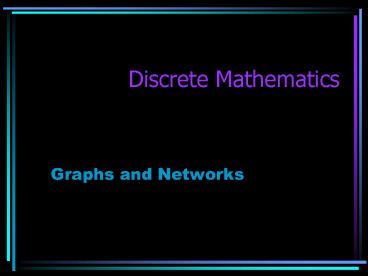Discrete Mathematics - PowerPoint PPT Presentation
1 / 18
Title: Discrete Mathematics
1
Discrete Mathematics
- Graphs and Networks
2
Graphs and networks
- One of the most well known graphs is the map of
the London Underground.
3
Definitions
- Nodes - the vertices of the graph
- Arcs or edges the lines joining the arcs
Loop an arc connecting a node to itself
Multiple arcs two or more arcs joining the same
nodes
Simple graph a graph without loops or multiple
arcs
4
Definitions
- A sub-graph is part of a graph.
(a) and (b) are sub-graphs of graph (c)
Graph (c) is an example of a complete graph which
is a graph in which each node is connected to
every other node by precisely one arc. The
notation used is Kn where n is the number of
nodes Graph (c) is K3 Graphs (d) and (e) are
further examples.
(e)
K5
5
Definitions
- Bipartite graphs
6
The Königsberg bridge problem.
- The city of Königsberg has seven bridges
crossing the River Pregel. Can you devise a
circular route which crosses each bridge once
only.
The problem can be represented by a graph with
four nodes (land masses) and seven arcs (bridges).
7
Leonhard Euler
- Euler, an 18th Century mathematician, is known
as the father of graph theory. He was supposed
to have devised one of his theories based on the
Königsberg bridge problem. - He realised that for a circular route
- a land mass is entered the same number of times
it is left. - each land mass would need to be linked to the
other land masses by an even number of bridges. - Therefore each node has to have an even
- number of arcs.
- The nodes in this problem have orders
- 3, 3, 3 and 5. (the order is the number
- of arcs meeting at the node)
- Therefore no circular tour is possible.
8
More definitions
- A trail or route is a continuous sequence of
arcs leading from one node to another. - A path is a trail in which no node is passed
more than once. - A closed trail is one in which the starting node
and finishing node are the same. - A cycle is a closed trail where only the first
and last nodes are the same. - A connected graph is one in which, for any two
nodes, a path can be found connecting them.
9
Eulerian Graphs
- A Eulerian Graph is a graph which has a closed
trail containing every arc precisely once.
A closed trail exists A B C D B E
A It is therefore Eulerian
A closed trail does not exist (it would have to
contain BC twice) It is not Eulerian
A connected graph is Eulerian if, and only if,
every node has an even order.
10
Semi-Eulerian graphs
- Can you draw this diagram
- without taking the pencil
- off the paper?
To do this you need to draw a trail which is not
necessarily closed. It is a semi-Eulerian graph.
i.e. there is a trail which is not closed that
contains every arc precisely once.
A connected graph is semi-Eulerian if, and only
if, precisely two nodes have an odd order.
11
Practice questions
- Exercise 2A page 21
12
Planar graphs
- A planar graph is one which can be drawn in
one plane in such a way that arcs only meet at
nodes and do not cross. - e.g.
The first graph can be redrawn so that no arcs
cross, so it is planar.
13
Eulers relationship
- Euler noticed a relationship between the
regions (R), the nodes (N) and the arcs (A) of a
planar graph. - R N A 2
- For a graph to be planar it must obey Eulers
relationship.
14
Trees
- A connected graph with no cycles is a tree.
Features of trees Every connected graph contains
a tree which contains every node of the graph. A
family of saturated hydro-carbons can be drawn as
trees.
15
Practice questions
- Exercise 2B page 25
16
Network problems
Directed graphs The arcs may have arrows
indicating a direction representing one-way
streets, flow of a manufacturing process etc.
These graphs are directed graphs or digraphs.
- Weighted graphs
- A numerical value may be attached to an arc
representing distance, cost etc. This value is
called the weight of the arc.
17
Matrices
A B C D
A - 2 4 -
B 2 - 3 -
C 4 3 - 1
D - - 1 -
An undirected graph will have a symmetrical matrix
To
A directed graph is not symmetrical. It is
important to indicate the direction in the matrix.
A B C D
A - 2 4 -
B - - 3 -
C 5 - - 1
D - - 1 -
From
18
Practice questions
- Cambridge Advanced Level Maths
- Discrete Mathematics 1
- Chapter 2
- Exercise 2 A page 21
- Exercise 2 B page 25
- Exercise 2 C page 28
- Miscellaneous Exercise 2 page 29































